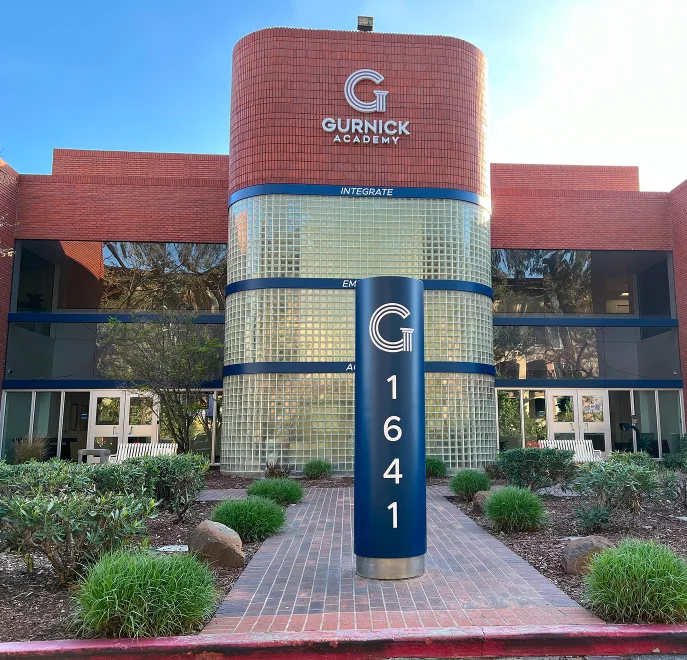Gurnick Academy of Medical Arts

Key Outcomes
60% reduction in unauthorized access attempts within six months (from an average of 10 per month to just 4)
$15,000 in annual labor savings by reducing the need for on-site patrols by 20%
Faster interventions—security teams could act before a breach occurred, helping ensure compliance with healthcare privacy regulations
When Aaron Tilbury stepped into his role as Director of Campus Safety at Gurnick Academy of Medical Arts, he faced a complex challenge: protecting students, staff, faculty, and sensitive medical training environments across six campuses spread throughout California.
The Academy’s mission—to prepare the next generation of nurses, imaging technologists, and healthcare professionals—relies on high-quality training in simulation labs and clinical spaces. Good but outdated, legacy security systems made it difficult to see what was happening in real time, let alone respond quickly. Without a centralized view, each campus operated in its own silo, leaving key areas vulnerable.
“We had to shift from reacting to incidents after the fact to being able to prevent them from happening in the first place,” Aaron recalls.

From Risk Assessment to Modernization
Brought onboard by the company’s CEO to modernize campus safety across the organization, Aaron began by walking each campus, from busy simulation labs to quiet administrative offices, identifying vulnerabilities and bottlenecks. Gurnick needed a unified, real-time platform that could scale across all campuses and meet California’s education and healthcare facility standards. “Standardizing safety and security across all campuses is no longer a luxury - It is a necessity. Partnering with Verkada has helped us streamline response protocols and ensure consistent protection across our campuses,” says Fred Faridian, Vice President of Campus Operations. Partnering with Assure MSP, Aaron then led the deployment of Verkada’s cloud-managed security platform:
Hybrid Cloud Cameras provided 24/7 recording with AI-powered analytics like motion detection, face match, and loitering alerts. Privacy features—such as live face blur and selective archival blurring—helped protect student privacy during investigations.
Horn speakers and line crossing technology helped remotely monitor the facilities, deterring crime through audio-visual means.
Integrated Access Control restricted entry to sensitive areas like nursing labs, medication storage rooms, and administrative offices. Automated provisioning and role-based permissions help ensure that only authorized personnel could enter these spaces, supporting compliance with healthcare regulations.
Through Verkada Command, Aaron and his team could now monitor all campuses from one interface, receive instant alerts, and share critical video evidence directly with staff or law enforcement via secure links.

Stopping Incidents Before They Happen
Shortly after implementation, Aaron noticed a troubling pattern at the Concord campus: repeated attempts of tailgating incidents made it difficult for staff to manage access to the administrative offices, classes, and clinical training labs.
Using Verkada’s mobile app he provided authorized individuals access to the academic floor. By using AI capabilities, he configured cameras at lab entry points to detect persons of interest and send SMS alerts to the security team. These alerts often arrived before an unauthorized individual reached the door, enabling security staff to intervene in real time.

In another occasion at the San Jose campus, the line crossing feature of the camera notified remote monitoring agents about an individual approaching a car that was parked overnight in the parking area surrounding the campus. A remote agent activated the horn peaker informing the individual that the campus was private grounds and asked the individual to leave the area. Mobile patrol was dispatched observing the individual leaving without any physical altercation. This level of automation has reduced labor overtime.

Within six months, unauthorized access attempts dropped by 60%, while door-propping and tailgating incidents declined by 40% in high-traffic areas. Reduced patrol needs translated into approximately $15,000 in annual labor savings, without compromising safety.
“The ability to get an alert in real time and act before someone gets through the door is a game changer,” Aaron says.
A Safer, More Connected Campus Network
Today, all six Gurnick campuses operate under a single, proactive security framework:
Faster Investigations: Staff can locate relevant footage in minutes by describing a person, vehicle, or behavior in everyday language, or by uploading a reference image.
Stronger Compliance: Role-based permissions, audit logs, and encryption safeguard sensitive information, aligning with healthcare privacy regulations.
Prepared for Emergencies: From Command, staff can remotely lock or unlock doors to aid first responders, or trigger campus-wide lockdown scenarios with a single click.
For Aaron, the investment has paid off in more than metrics—it’s transformed how the Academy approaches safety.
“With Verkada, we’ve gone from chasing down problems to staying ahead of them,” he reflects. “It’s about protecting our people, safeguarding our spaces, and supporting the education that changes lives.”
